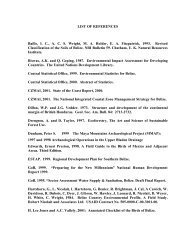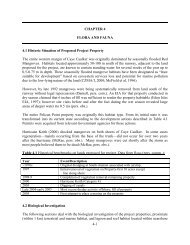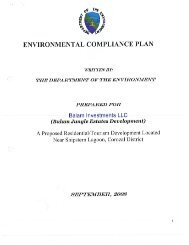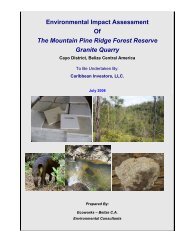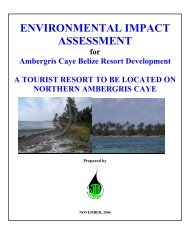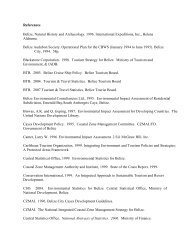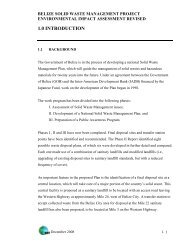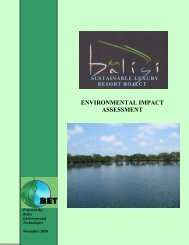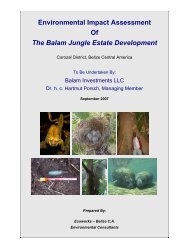Project Environment - Department of Environment
Project Environment - Department of Environment
Project Environment - Department of Environment
Create successful ePaper yourself
Turn your PDF publications into a flip-book with our unique Google optimized e-Paper software.
The western portion <strong>of</strong> the project site is the only exposed area and therefore it is evident that the<br />
erosion process has eroded some <strong>of</strong> the land. In order to prevent erosion, it is anticipated that a<br />
sea wall will be constructed and placed along the coast.<br />
Apart from seasonal variations in wind conditions and sea states, catastrophic storm events are<br />
an attendant risk <strong>of</strong> residing in coastal Belize. Although no site-specific modeling has been done<br />
for Caye Caulker, projections for a Category 5 Hurricane with wind speeds <strong>of</strong> 175 mph entails<br />
storm surges <strong>of</strong> 10-18ft. above mean sea level (MSL).<br />
2.3.4 Tides and Currents<br />
The currents influencing the depositional and erosion processes <strong>of</strong> the proposed project site are<br />
derived from both wind-driven and tidal sources. The wind driven currents are greater in<br />
magnitude and are in general more influential in affecting the dynamics <strong>of</strong> the cayes and the<br />
ecosystems <strong>of</strong> the surrounding waters. Wind driven currents in the Belize have been recorded at<br />
1-1.5 knots at the immediate sub-surface and 0.2-0.6 knots at a depth <strong>of</strong> 1.8 meters (FAO/UNDP<br />
unpublished report, 1983).<br />
The tidal action within the project site is classified as semidiurnal mixed tides, with generally<br />
four peaks in any given tidal day as follows: a high high, a high low, a low high and a low low<br />
tide (Hanson & von Twistern , 1996; National Meteorological Service, pers. com.). Generally<br />
tidal variation is 0.3-0.5 m, raising to 0.8 m during spring tides or associated with storm action<br />
(See Fig. 2.7 for tidal influences).<br />
Tides also affect currents. Narrow cuts such as the Caye Caulker Split funnel can have strong<br />
currents sufficiently fast as to threaten all but those strong swimmers using fins. Channels in the<br />
reef will also reflect tidal currents depending upon their dimensions. Hol Chan Channel also<br />
shows strong current speeds during peak tides, while the larger channels <strong>of</strong>f Caye Caulker<br />
exhibit slower speeds. During the high tides, the currents at the Caye Caulker split and the<br />
channel travel inland and during low tide regress back out to sea. There are also lateral currents<br />
that can affect the project site and impact the reclaimed beach and the moored boats. This lateral<br />
current is neither strong nor prevalent, nevertheless this effect must be mitigated in order to<br />
prevent further beach erosion and to protect the boats whilst moored to the marina.<br />
The prevailing water movement entering the Caribbean is the wind-driven Guiana Current,<br />
flowing from southeast to northwest; this becomes the Caribbean Current, flowing through the<br />
Lesser Antilles with the majority reaching the Yucatan Strait (Hanson & von Twistern, 1996).<br />
The current breaks at Rocky Point, northern Belize, to form a small gyre that drives the sea <strong>of</strong>f<br />
Belize to flow from north to south (Perkins, 1983).<br />
While the prevailing current flow moves from north to south, powerful northerly winds during<br />
cold fronts or other storm events may generate temporary strong currents that may carry<br />
materials such as sediments as far as the Mesoamerican Barrier Reef System (MBRS). These<br />
currents vary seasonally and, though charted in general, have not been studied in detail (Hanson<br />
& von Twistern, 1996).<br />
2-12




